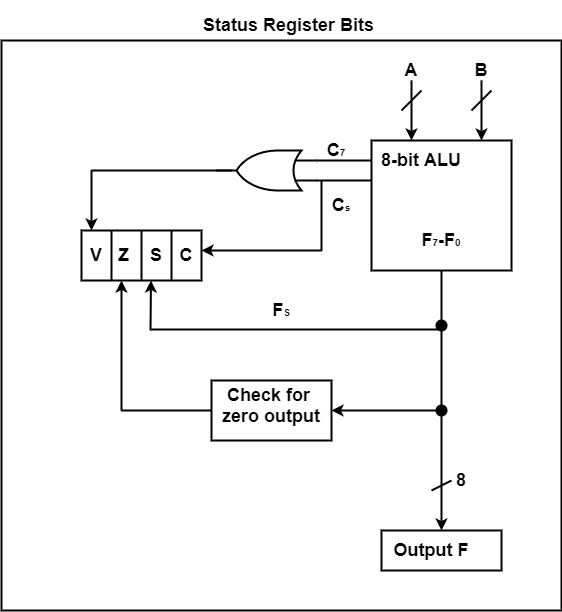
 Data Structure
Data Structure Networking
Networking RDBMS
RDBMS Operating System
Operating System Java
Java MS Excel
MS Excel iOS
iOS HTML
HTML CSS
CSS Android
Android Python
Python C Programming
C Programming C++
C++ C#
C# MongoDB
MongoDB MySQL
MySQL Javascript
Javascript PHP
PHPPhysics
Chemistry
Biology
Mathematics
English
Economics
Psychology
Social Studies
Fashion Studies
Legal Studies
- Selected Reading
- UPSC IAS Exams Notes
- Developer's Best Practices
- Questions and Answers
- Effective Resume Writing
- HR Interview Questions
- Computer Glossary
- Who is Who
What are the conditions of Status Bits in Computer Architecture?
The status register comprises the status bits. The bits of the status register are modified according to the operations performed in the ALU. The figure displays a block diagram of an 8-bit ALU with a 4-bit status register.

If the end carry C8 is 1, then carry (C) is set to 1. If C8 is 0, then C is cleared to 0.
If the highest order bit F7 is 1, then Sign (S) is set to 1. If F7 is 0, then S is set to 0.
If the output of ALU is 0, then zero (Z) is set to 1, otherwise, Z is set to 0.
If the XOR of the last two carries is equal to 1, then overflow (V) is set to 1, otherwise, V is cleared to 0.
The result of the 8-bit ALU operation is either 127 or -127.
Z is a status bit used to indicate the result obtained after comparing A and B. Here, the XOR operation is used to compare two numbers (Z = 0 if A = B).
Conditional Branch Instruction
The conditional branch instruction checks the conditions for branching using the status bits. Some of the commonly used conditional branch instructions are shown in the table.
Conditional Instructions
| Mnemonic | Condition | Tested Condition |
|---|---|---|
| BZ | Branch if zero | Z = 1 |
| BNZ | Branch if not zero | Z = 0 |
| BC | Branch if carry | C = 1 |
| BNC | Branch if no carry | C = 0 |
| Branch if zero | Branch if plus | S = 0 |
| BM | Branch if minus | S = 1 |
| BV | Branch if overflow | V = 1 |
| BNV | Branch if no overflow | V = 0 |
| Unsigned compare conditions (A –B) | ||
| BHI | Branch if higher | A > B |
| BHE | Branch if higher or equal | A ≥ B |
| BLO | Branch if lower | A < B |
| BLOE | Branch if lower or equal | A ≤ B |
| BE | Branch if equal | A = B |
| BEN | Branch if not equal | A / B |
| Signed compare conditions (A – B) | ||
| BGT | Branch if greater than | A > B |
| BGE | Branch if greater or equal | A ≥ B |
| BLT | Branch if less than | A < B |
| BLE | Branch if less or equal | A ≤ B |
| BE | Branch if equal | A = B |
| BEN | Branch if not equal | A / B |
Thus, when the status condition is true, the program control is transferred to the address specified in the instruction, otherwise, the control continues with the instructions that are in the subsequent locations. The conditional instructions are also associated with the program control instructions such as jump, call, or return.
The zero status bit checks if the result of the ALU is zero or not. The carry bit checks if the most significant bit position of the ALU has a carryout. It is also used with rotate instruction to check whether or not the bit is shifted from the end position of a register into a carry position.
The sign bit indicates the state of the most significant bit of the output from the ALU (S = 0 denotes positive sign and S = 1 denotes negative sign). The branch if plus and branch if minus is used to check whether the value of the most significant bit represents a sign or not. The overflow and underflow instructions are used in conjunction with arithmetic operations performed on signed numbers.
The higher and lower words are used to denote the relations between unsigned numbers, whereas the greater and lesser words are used to denote the relations between signed numbers.

